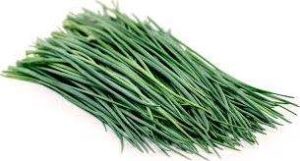Chive
The Herb (Chinese) Chive
Chives are a relatively easy plant to keep, and you get a lot of pleasure from them in the kitchen.
Here you can read about how both the common and the Chinese chive
fits.
Characteristics Chives and Chinese Chives
- Family: Liliaceae
- Species: Allium schoenoprasum (chives), Allium tuberosum (Chinese chives)
- Originates from: China
- Biotope: Permeable soil, temperate zones; Central Asia.
Chives have dense, white to purple flower heads and bunches of tiny bulbs and leaves (resembling hollow stems). Chives are from the same family as garlic.

Chinese chives have a rhizome and star-shaped, white flowers.
Name in Different Languages
- English: Chive
- German: Schnittlauch
- French: Ciboulette
- Italian: Aglio selvatico
- Spanish: Ajo morisco
Usage and Application
You use the leaves of chives, although you might call them stalks. They taste fresh with a mild onion flavor (a touch of garlic).
In the most kitchens, chives are mainly used in salads and dressings. However, the herb fits in more dishes.
Chinese cuisine is used with meat or fish dishes, but also in sauces and as garnish.
The leaves (or petioles) of Chinese chives (Allium tuberosum) have a garlic flavor and are a little spicier than the ‘normal’ chives (Allium schoenoprasum).
In China, the leaves and stems of this type of garlic are blanched. In Chinese cuisine, flower buds and stalks play an essential role.
The Seeds are Used as a Tonic
Many varieties of chives are cultivated. Some chives taste like lemon or have a strong garlic odour.
Chinese chives are one of the oldest varieties.